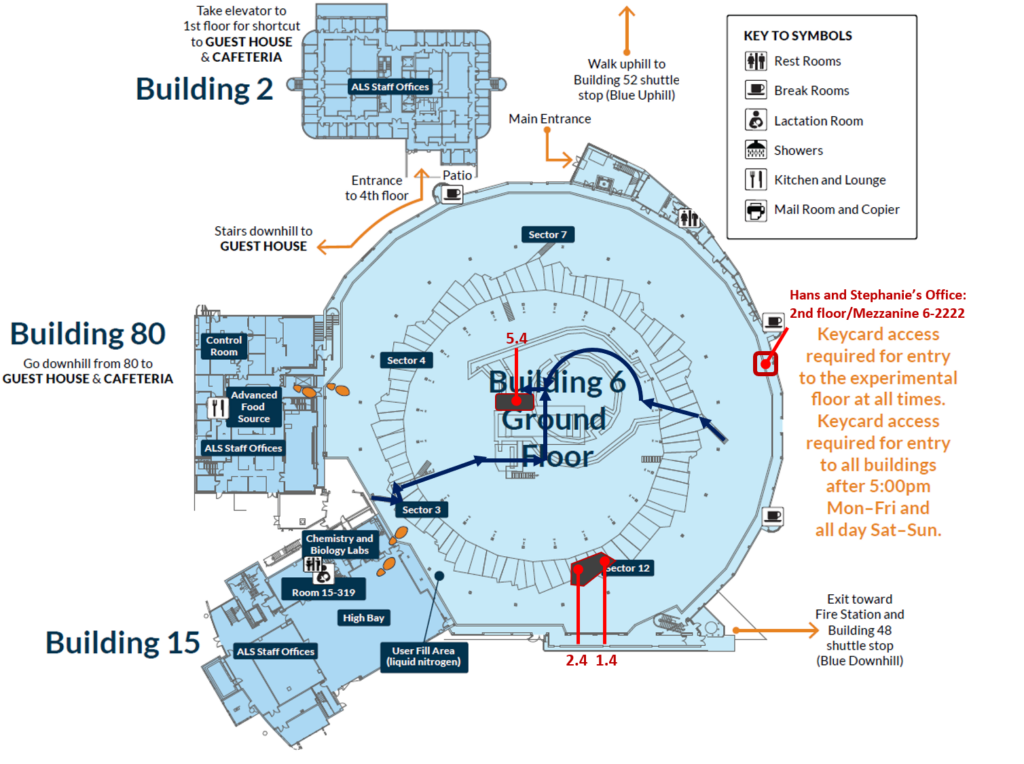Frequently Asked Questions
Answers to common questions can be found below. If you still have questions after reviewing the list, please contact Hans or Stephanie for more information.

Where are the IR beamlines located? Beamlines 1.4 and 2.4 are located on the experimental floor in sector 1.The entrance to the beamlines is just past the long hallway of cabinets in sector 12. Beamline 5.4 is located on top of the accelerator — to access this location, use the yellow stairs by beamline 4 or beamline 11 to go over the storage ring (access paths are indicated by blue arrows in floor plan image). Beamline 5.4 is located in a cabin on top of the linac.
How do I know which beamline to select when submitting a general user proposal (GUP)? Please contact the beamline staff prior to submission to discuss which beamline is best suited for your measurements and also receive guidance on feasibility and sample preparation.
What is the difference between synchrotron IR micro-spectroscopy and synchrotron IR nano-spectroscopy? Both techniques rely on the light produced by the synchrotron and Fourier Transform Infrared (FTIR) spectroscopic methods; however, microspectroscopy is a far-field measurement technique that is diffraction-limited (the spatial resolution is limited by the wavelength of the light) and nanospectroscopy (nano-FTIR) is a near-field technique that uses an atomic force microscope (AFM) probe to achieve spatial resolutions limited by the probe diameter (~25 nm). Microspectroscopy is therefore useful in measuring large areas rapidly and when features or chemical constituents are segregated on the order of tens of µm or larger. Nano-FTIR is able to detect inhomogeneities on the order of 50 nm – few µm.
What kind of samples are suitable for nano-FTIR? We are presently able to accommodate materials that are both compatible with AFM (atomic force microscopy) and stable in a dry nitrogen environment. We are presently not able to offer air-free/UHV or cryo environments.
What is the difference between SINS and Nano-FTIR? SINS is a specialized version of nano-FTIR that uses the broadband synchrotron source. Nano-FTIR is the more general term for the technique that could be used with any broadband source.
Should I use an aperture to improve the spatial resolution of my far-field measurements? For globar source measurements, the spatial resolution is determined by the aperture size at the expense of light throughput. For the synchrotron source, the spot size is already diffraction-limited, but the use of confocal apertures will still improve the spatial resolution by reducing the contribution of the first-order diffraction ring. However, the optimal aperture setting is dependent on wavelength and can be a compromise between spatial resolution and throughput. We often do not use apertures with the synchrotron beam but have the apertures in place fully open to improve the nitrogen purge.
What is a wavenumber? The number of waves in a length of 1 cm is a wavenumber: 𝝂 = 1/𝜆 = 𝜈/c
Will the synchrotron infrared light damage my samples? It is very unlikely that sample damage will occur from the light itself as infrared is non-ionizing and the temperature rise associated with far field (microspectroscopy) measurements is < 0.5 degrees. For nanospectroscopy measurements, the presence of the tip could have an effect by localizing the field, but our experience has shown that any sample damage is usually mechanical and not light induced.
Microspectroscopy Terminology:
Spatial Resolution vs. Pixel Resolution: Spatial resolution for a far-field microscope is diffraction-limited: on the order of the wavelength of light, depending on the numerical aperture of the objectives used. The resolution and wavelengths of light needed for your experiment may determine which far-field instrument is suitable.
FPA microscopes frequently have pixel resolutions smaller than the longest wavelengths available, but that does not mean the spatial resolution is defined by the pixel resolution – the diffraction limit of the light is still the defining variable in this case. If the pixel resolution is larger than the diffraction-limit, then the pixel resolution will determine your spatial resolution.
For the best possible spatial resolution, an IR microscope operating in a confocal geometry with a single point detector will be best choice to remove the higher order diffraction rings of the Schwarzschild objective, but the FPA microscope has a very large multiplexing advantage and is arguably best for a globar or other low-brightness sources.
It is possible to improve the spatial resolution slightly by oversampling and then applying deconvolution techniques, but this also has limits.
Nanospectroscopy Terminology:
Optical Contrast: The dominant contrast mechanism in near-field images arises from changes in optical properties (dielectric constants) that are present at the imaging frequency.
Nano-Imaging: near-field imaging of a material at a single frequency, typically with a laser-based light source. Nano-imaging is able to produce high quality images with monochromatic illumination. This method is useful for providing information (optical contrast) on the localization of specific minerals/compounds if the light is tuned to an absorption resonance of the mineral/compound under interrogation. This technique is available at Beamline 2.4 with tunable QCL and CO2 lasers.
Whitelight Imaging: near-field imaging of a material with broadband light (spectrally integrated). The optical contrast in this type of imaging is useful for identifying a region of interest for nano-FTIR measurements, but is difficult to make quantitative statements about the image without further measurements. Very generally, more white light response = more conducting or reflective. This technique is available at Beamlines 2.4 and 5.4 during user operations.
Nano-FTIR: Fourier Transform Infrared spectroscopy with sub 25 nm spatial resolution. This technique requires a broadband light source and produces point spectroscopy over a broad spectral bandwidth.
SINS: Synchrotron Infrared Nanospectroscopy is a type of Nano-FTIR which uses the synchrotron as an ultrabroadband light source. This technique is available at 2.4 and 5.4 during user operations.